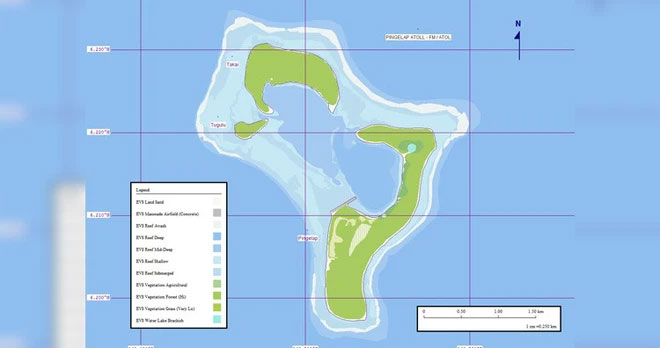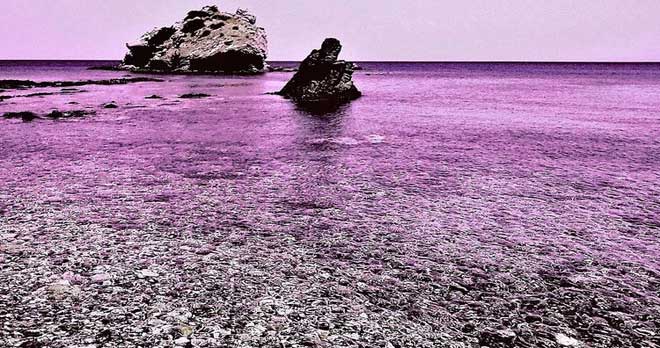Explore the 'color blind island': Home to 250 residents and 10% of them are completely color blind
Imagine you are surrounded by a colorful world but cannot fully perceive it. It sounds sad but this is a reality for people who are color blind. Not everyone has perfect color vision. But can you imagine an island where 10% of the population is color blind and completely color blind?
Pingelap, a small atoll in the Pacific Ocean, has an unusually high number of color blind inhabitants. What's more, it's not typical color blindness - one where you have a hard time distinguishing between red and green or blue and yellow. The color-blind inhabitants of this tiny island can almost see the world in black and white.

Pingelap Atoll consists of three islands and covers a land area of 455 acres. It has its own language and population of 250.
Located in the Pacific Ocean, Pingelap Atoll is part of the State of Pohnpei. It consists of three islands, but Pingelap is the only inhabited island. This atoll covers an area of 455 acres, less than 4km wide at its widest. Pingelap has 250 population and its own language is called 'Pingelapese'. Most of the island's inhabitants speak this language. The island has a tropical climate, with warm and uniform temperatures all year round.

The island's most notable feature is that 10% of its population is completely colorblind, and that was the result of a violent storm that took place in 1775.
In 1775, a deadly storm called "Lengkieki" devastated Pingelap and killed most of the island's inhabitants. After the storm and the famine that followed, there were only about 20 survivors left on the island.
One of the survivors, who was also the ruler of the island at the time - King Okonomwaun, is believed to have carried the gene that is now known as "CNGB3". This gene is located on Chromosome 8 and is responsible for one of the most common rod monomorphisms. This recessive genetic disorder is known to cause total color blindness or complete heterochromia.
Cultural and geographical isolation is believed to have led to generations of inbreeding among survivors and made the recessive gene common. Interestingly, however, carriers of this gene do not have the disorder.
The founder effect is the loss of genetic variation that occurs when a new population is formed by a very small number of individuals from a larger population. It was first outlined entirely by Ernst Mayr in 1942, using existing theoretical work by the likes of Sewall Wright.
Color blindness occurs as a result of inbreeding and the "founder effect", which is why all the color blind people on the island can trace their ancestry back. with the original ruler having the CNGB3 gene. Furthermore, people with this disorder have difficulty seeing in sunlight. However, their night vision is much stronger than that of people without the deformity, and they can easily detect movement or objects in low-light environments.

The CNGB3 gene was first identified in 2000 by a team of researchers at John Hopkins University School of Medicine.
After more than 30 years of studying Pingelap and the island's color-blind population, scientists were finally able to find the answer in 2000. Geneticists Irene Hussels Maumenee and Olof Sundin of the School of Johns Hopkins University Medicine examined the DNA of 32 inhabitants of the island, only 50% of whom were colorblind. After some testing and research, they were finally able to track down the gene that causes the condition. Their report was published in the journal Nature genetics.
To this day, Pingelap Atoll is a topic of interest to geneticists around the world. The combination of a small genetic pool and rapid population growth has made achromatopsia unusually common on the island. Nearly 10% of the island's population is colorblind. In the United States, only 0.003% or 1 in 33,000 people are color blind.

Eric, a resident of Pingelap Island, is colorblind. Pingelap has only one street and doesn't have any shops or restaurants. The people on the island make a living by picking coconuts and catching fish. At the end of the 18th century, a tsunami claimed the lives of all the people on the island, only 20 people survived, including a king. This person then gave birth to many descendants to rebuild the island. Many of his descendants carried the rare gene for achromatopsia (complete color blindness), which continued to be passed down through generations of the islanders.

People on Pingelap Island say they mostly see red, purple and blue, but mostly only see black and white. But in a monochrome world of colorblind people 'color' is just an abstract word.

In broad daylight, the island's color-blind people's world looks like a burnt photograph. They must keep their eyes closed when stepping outside. For them, day and sunlight is a torture.
- A method to cure color blindness has been found
- Why do human eyes have different colors?
- Breakthroughs help artists 'listen' to colors
- New method to cure blindness
- Blind people look at things different from ordinary people
- The strange island is dominated by the blind toad
- Israel develops contact lenses for people with color blindness
- Visiting paradise island only 48 inhabitants live
- Explore the strip of land with 7 vibrant colors
- Chameleons can change color blind?
- How did Easter Island decline?
- Explore the beautiful island of paradise in
 The truth about the mysterious red-haired giant at Lovelock Cave
The truth about the mysterious red-haired giant at Lovelock Cave Inunaki Tunnel: The haunted road leading into Japan's 'village of death'
Inunaki Tunnel: The haunted road leading into Japan's 'village of death' The mystery of the phenomenon of human reflection before dying
The mystery of the phenomenon of human reflection before dying 6 mysterious phenomena, although science has been developed for a long time, still cannot be answered
6 mysterious phenomena, although science has been developed for a long time, still cannot be answered Mysterious Skull Island: A place where tourists can only see but not set foot
Mysterious Skull Island: A place where tourists can only see but not set foot  Revealing the mystery of the woman who lived alone for nearly two decades on a deserted island
Revealing the mystery of the woman who lived alone for nearly two decades on a deserted island  Giant cockroaches thought extinct 80 years ago suddenly appear in Australia
Giant cockroaches thought extinct 80 years ago suddenly appear in Australia  Why is it difficult to attract people to live on this beautiful island, which has houses provided by the government for 20,000 USD?
Why is it difficult to attract people to live on this beautiful island, which has houses provided by the government for 20,000 USD?  The mysterious 'Eye' island floating in the middle of the swamp
The mysterious 'Eye' island floating in the middle of the swamp  The world's first artificial energy island
The world's first artificial energy island 